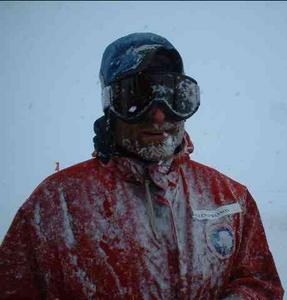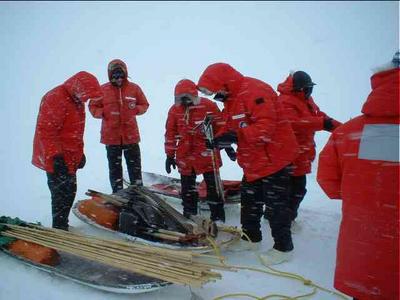21 December, 2002
McMurdo-Happy Camper School
NOTE to my readers: Remember to be patient with me-connectivity from
McMurdo is rather slow and there are only ten phone lines out of the
whole station and about 1000 people here. Sometimes I can only get a
few e-mails, including journals, out and I lose my connection. When
I get to the field, it may be even more difficult. I have a few
journals and pictures still to post on earlier dates, so keep
checking! Also, pictures are sent as separate e-mails, so it is
possible that a journal will be posted and then the pictures will go
up several days later. In other words, keep checking back! Also, if
you see acronyms or terms you don't understand, go back to the
journal posted Dec. 13 to find a list of terms.
McMurdo Weather:
CONDITION 3: Any weather better than Condition 2. Business as usual.
CONDITION 2: Visibility poor. Wind speeds up to 55 knots. Wind
chills up to minus 99 degrees. Dress warmly and be aware of your
surroundings and where you can take shelter.
CONDITION 1: Visibility less than 100 feet. Stay put. Use your
survival training to seek shelter. If you are caught outside and it
is possible, radio your location to Mac Ops.
Happy Camper School:
Weather conditions deteriorated during the night Thursday, so when we
arrived for our snow and survival training on Friday, it was
questionable whether our instructors would be allowed to take us into
the field or not. We were dressed in all our ECW gear which is
awfully warm for sitting inside, so we removed as many layers as
possible. Most of us were wearing our wind pants and long underwear
tops. We slipped off the huge bunny boots, and walked around in our
socks.
Brian taught us to use our survival stoves, an important skill
because if you are caught outside in a Condition 1 situation, you
could melt snow to drink. Staying hydrated is an important part of
staying warm. The stoves also heat your tent as you are melting the
snow.
Helicopter Safety:
We watched the helicopter safety videos and learned how to approach
and enter a helo. The blades will always be turning when you enter
because when they stop, they dip down and can be lower than a
person's head. The main things to remember when approaching a helo is
to wait for the thumbs up from the pilot and then approach from the
front and side. Never walk toward the back. There is a blade on the
tail that rotates so fast you can't see it. A gross joke was that if
your hat blows back there, let it go, because if you go after it you
won't need it anymore. (Yuck!) Also, if the helo is on a slope,
approach it from the downhill side.
Survival Training Outdoors:
Weather conditions around McMurdo kept changing between Condition 2
and Condition 1, but finally after lunch it was decided to take us
out to the ice sheet and do the survival training outside. After all,
if we are ever in need of survival skills it will probably be during
a Condition 1 storm.
The sixteen "NG's" (new guys) piled into the Nodwell, a huge
tractor-wheeled contraption, which lumbered around Ob Hill and headed
out on the ice shelf. We worked as a team to unload our gear from the
Nodwell and from the survival shed. Half the team began cutting ice
blocks. I joined a team of four in the cab of "Uncle Ben", a Haglund.
For a moment I felt like my older dog, Canuck, who needs a boost to
get up into the back of my jeep. The tractor tires are about four
feet off the ground and I was standing in full ECW gear (about 35
pounds) with my boots sunk into snow about a foot deep, trying to
scramble up on the tractor treads to reach the door handle a foot or
so above my longest reach. I did it, but was glad no one was filming,
because I'm sure it was far from graceful! The cab was so loud we had
to wear ear protection as we bounced down the road to another shed.
The snow was blowing straight at the windshield and our driver had
trouble seeing the flags marking the road. Every once in awhile, the
door next to me would pop open! This was not the safest ride I had
ever experienced. Together we formed a line and loaded sixteen "sleep
kits" into the Haglund. The kits were large duffel bags with two
pads and a sleeping bag for each person.
Back in camp, we all worked as a team to build our shelters.
Visibility was almost zero as the wind howled and froze icicles on
the guys' beards. The snow blew horizontally and as I laughed out
loud I almost choked on the parcticles driving down my throat with
great force. I tried to keep my mouth shut after that experience!
Our Snow Mound City included two large ice block walls which each
sheltered two mountaineering tents. We also pitched two Scott tents.
(See the pictures.) Several pairs of brave souls found ice shelters
from former survival classes and excavated them for their overnight
homes. Jen and I moved into a mountaineering tent. They are made
for two, but there is no room to move around in them at all.
Fire in the Tent:
Before bed, we joined Ryan and Sarah in the Scott tent for dinner.
They had the stoves burning and heated water for half the group. The
Scott tent can comfortably sleep three, but with two it is downright
roomy. Six of us sat and ate in it and enjoyed the coziness of being
together and listening to the roaring storm outside. Our meals
wereŠwell interesting. I had freeze dried teriyaki chicken. It
wasn't awful. 'Nuf said?
The survival stoves burn liquid fuel. As we were filling the
bottles, a little fuel spilled on the stove board. We wiped it up as
best we could, turned the board upside down, and then lit the stove.
With a WHOOSH the flames engulfed the stove, but more importantly
they also flowed under the stove board and licked out toward our
boots! For a few tense seconds we looked for something to smother it
with, but nothing worked. We finally doused it out with water and
then had to deal with the flood on the floor of the tent. There was
no damage to tent or persons, but we had a good story to tell!
I was concerned about being cold in the night, so I filled my water
bottle with boiling water. THAT was a good move-I snuggled with it
until it finally cooled off about four in the morning. By then I had
my sleeping bag warmed up and was able to regulate the heat without
help. You have to be diligent about how warm or cold you are and then
do something to fix the problem before it gets out of hand. Believe
it our not, a few times I got too warm, but I had to be careful not
to cool off too much. Our instructors told us to have food with us
in our tents. If we got cold we should eat something in the middle of
the night. Oh boy! I have permission to eat chocolate whenever I want!

1. Allan O'Bannon, our survival instructor. Check out the ice on
his beard!

2. I am wet. It is cold. I am still smiling!

3. The Nodwell--huge people and equipment mover over snow and ice.
It is slow and cumbersome, but it works! It is similar to Uncle Buck,
the Haglund.

4. Moving the equipment through the storm to out campsite.
Contact the TEA in the field at
.
If you cannot connect through your browser, copy the
TEA's e-mail address in the "To:" line of
your favorite e-mail package.
|
